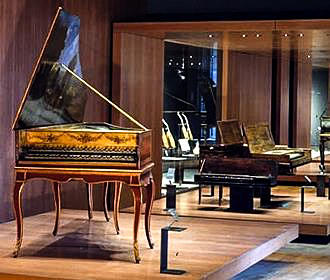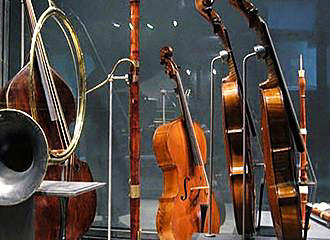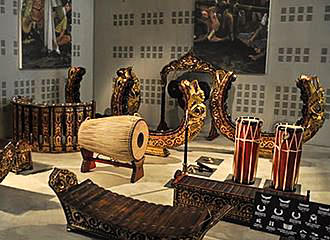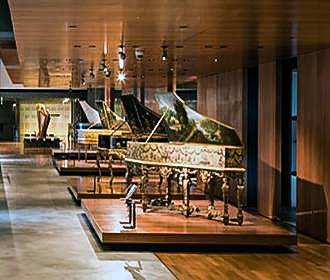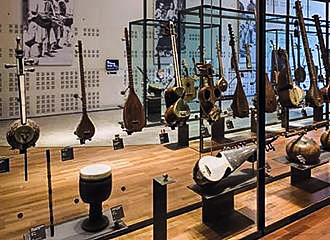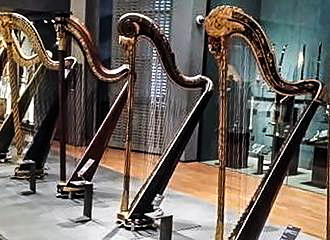Musee de la Musique museum in Paris
The Musee de la Musique is home to one of the richest collections of musical instruments in the world, but is more than just another museum in Paris as you can actually listen to musicians playing on some of these fabulous instruments, as well as discover more about their history, different types of music cultures, composers and much more.
About the Musee de la Musique
Situated within the cultural park in Paris called the Parc de la Villette, the Musee de la Musique is a museum linked with the Cite de la Musique that has two different concert halls and a multimedia centre, and the Philharmonie de Paris with its 2400 seat symphonic hall, that is home to the French Philharmonic orchestra, along with rehearsal rooms, etc, all of which are dedicated to music.
This music museum has a collection of over 7,000 different musical instruments, which makes it one of the largest collections in the world and the improved layout now provides even more space than originally with over 3,000 square metres of exhibition space to display even more instruments.
The Musee de la Musique is a fascinating place where you can discover the history of music and instruments from Baroque Italy to Opera, the music of Versailles and also the traditions of further afield to the Middle East, Asia and Africa.
And due to its extensive research and restoration laboratory this museum in Paris is internationally recognised and is often called upon by other museums throughout the world for their expertise and is therefore it also has a scientific centre for the preservation of instrumental heritage.
The Permanent Collections at Musee de la Music
Within the permanent collection on display at the music museum in Paris you will be able to discover works of art, paintings, sculptures and furniture along with many different types of musical instruments used, that also aims to provide a greater insight into how music plays a role in different cultures and history.
There are also five areas that show the instruments according to the composers, the places where the music was played or the type of repertoire along with displays presenting families of instruments or instrument makers such as Sellas and Sax.
And for those of you interested in learning more, there is another area dedicated to documentary films that cover areas such as the 17th century and the birth of opera, the 18th century and music of the enlightenment, the 19th century and romantic Europe, the 20th century and also world music.
Now when it comes to some of the musical instruments on display, you will be privileged to see a Pleyel piano that belonged to Frederic Chopin and an Erard piano that belonged to Franz List along with 17th century lutes from the Germanic-Italian school by Sellas.
There are also instruments of Adolphe Sax, baroque guitars, romantic French and Spanish guitars from the 19th century such as Torres and 20th century guitars such as Fender. You can also admire 17th and 18th century harpsichords along with instruments from the quartet of the Cremona school including a Stradivari violin dating from the start of the 1700s and an Amati violin.
In addition to these incredible musical instruments, the harpsichord of Ioannes Couchet dating from 1652 and another by Antoine Vater dating back to 1732 are also on display at the Musee de la Musique and have been classified as national treasures. But there are also others items that have recently been acquired that include a John D’Angelico guitar, which belonged to Jacques Liebrard who was an official accompanist to Edith Piaf, and the famous Bouchet guitars of the Presti-Lagoya duo.
Events at Musee de la Musique
Temporary Exhibitions
Although the museum has in itself a very rich collection, to try and appeal to a wider audience there are temporary exhibitions organised throughout the year on many different subjects such as music traditions of countries such as China or North India. There are also themed exhibitions on a more modern note like popular music and exhibitions dedicated to artists such as Jimmy Hendrix and John Lennon, etc.
Musicians Within the Museum
This museum is not just about viewing the objects on display, as there are guides on hand to discuss the instruments and music with you, and from a Tuesday through to a Sunday there are musicians that come into the Musee de la Musique every day from 2pm to 5pm to play some of the instruments and discuss them.
In addition to this, during the French school summer holidays there are special educational concerts, known as pedagogical concerts, that are held between 3pm and 4.30pm on all opening days.
Concerts and Concert-Promenades
Even though this music museum is committed to preserving historical instruments and its history, there are several concerts organised throughout the year where well known and up and coming artists come and play on instruments within the collection, and these are held within the Amphitheatre of the Cite de la Musique.
Mind you, there are unfortunately some musical instruments that are far too fragile to be played now or would require too much dangerous restoration work, and in this instance for the concerts, copy instruments that have been meticulously reproduced replace these.
Also, from October to May on the second Sunday of every month the Musee de la Musique Museum holds Concert-Promenades, which is where musicians, dancers and music historians spread out over the museum throughout the day.
Here they offer different mini concerts, performances, workshops and discuss different topics according to the exhibitions being shown, and the whole museum echoes with the beautiful sounds coming from these impressive musical instruments, which makes this an ideal time for the whole family to enjoy a fun way of discovering more.
Access to Musee de la Musique
The Musee de la Musique is open on a Tuesday through to a Friday from midday to 6pm, but on a Saturday and Sunday it opens from 10am through to 6pm, yet it is closed on a Monday and on major French National holidays such as 1st May.
The full price for admission is €8 as of 2018 and this also includes an audio guide which is available in French, English and Spanish for adults, or French and English for children. However for those under the age of 18 or under the age of 26 if an EU resident, entry to the museum and its permanent collections is completely free of charge.
A specially designed audio and sound guide has also been developed for the sight impaired, plus there are specific brochures distributed free in either French or English, one for Adults and another specifically designed for children aged 7 and up.
However you can also opt for a guided tour at a cost of €10 for an adult as of 2018 or only €6 for those under the age of 18 and these are held on specific days of the month, although we would like to point out that at present they are only conducted in French.
Because all of the lecturers at this music museum in Paris are musicians, historians, musicologists or ethno-musicologiests a guided visit can also be adapted to the needs of the group, when you book your own guide for a group visit of 10 or more people. This is a set price €220 including the admission price and conducted on specific days, these are possible in French, English, German, Italian, Russian and the Spanish languages. But we would like to point out that any group visits must be booked in advance, whether you wish to have a guide or not, and this can be arranged by telephone on +33 (0) 1 44 84 44 84.
For those of you that want to discover more on a specific subject for instance, then visitors have free access to the multimedia and documentation centre at the Cite de la Musique, which includes technical drawings, recordings of early instruments from the museums permanent collection, dossiers and much more. Yet by prior appointment, researchers can also consult original archives that have been built up since the museum was first founded back in 1861, and was originally called the Conservatoire National de Musique.
You will be able to discover the Musee de la Musique situated in the Parc de la Villette in the 19th Arrondissement, which is not far from the Boulevard Peripherie and this is located within the Cite de la Musique. The entrance is located by the Place de la Fontaine Aux Lions with its fountain and you have to go through an arcade called the Rue Musicale, which is topped by a long metal beam that runs along the Conservatoire de Paris facade, that then leads you to the music museum along with the concerts halls and the multimedia centre.
When it comes to arriving at the Cite de la Musique, you have the metro station called the Porte de Pantin on line 5, which also has an exit accessible to the disabled, or you could take the Tramway Line T3B or the bus lines 75, 139, 150,151, 152 and 330.
Yet if you are staying around this park in Paris until late after the normal transport systems have stopped operating, then the Noctilien Night Bus Service via Lines N13, N41, N42, N45 and N140, can get you back to the heart of Paris in the early hours of the morning.
Alternatively, if you driving in France and around Paris by car, then there is a fee paying underground car park located underneath the Cite de la Musique, which also has ten spaces that are reserved for disabled visitors, but we would like to point out that there is a maximum height of 1.9m.
And although the Musee de la Musique is accessible to the disabled, we would also like to point out that you would require assistance to open some of the doors, including to the toilet facilities.
